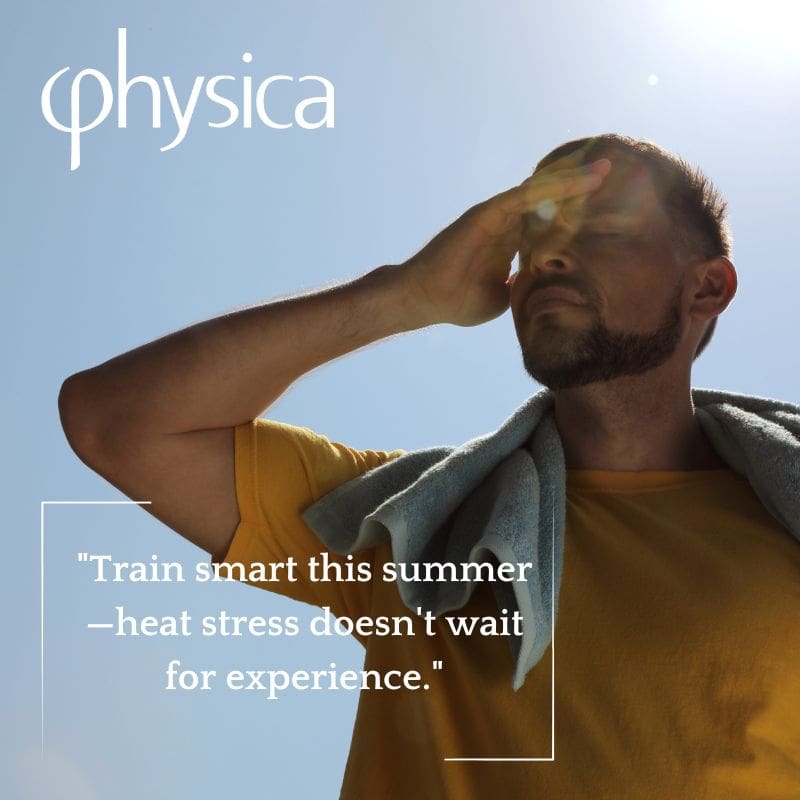by Matthew Anderson
As Melbourne’s summer approaches, many of us are eager to stay active outdoors—whether it’s running, cycling, tennis, or a simple walk in the sun. But with the heat comes an important safety consideration that every active person should understand: heat stress.
This isn’t just a cautionary tale. Heat-related illness can be life-threatening if not recognised and managed promptly. Whether you’re an elite athlete or weekend warrior, understanding how to prepare for and prevent heat stress could save your health—or even your life.
Why Heat Stress Matters in Australia
Australia’s climate, particularly in summer, creates challenging conditions for exercise. Heat stress doesn’t discriminate. It can affect:
- Runners and joggers
- Cyclists and tennis players
- Gym-goers or anyone exercising in hot environments
Being aware of the risks and knowing how to manage them is vital for performance, safety, and overall well-being.
New Guidelines from Sports Medicine Australia (SMA)
Sports Medicine Australia has released its 2025 update to the Extreme Heat Risk and Response Guidelines, introducing an innovative and free Sports Heat Tool to help you assess risk and plan your exercise safely.
What is the Sports Heat Tool?
The Sports Heat Tool is an online platform that provides real-time, sport-specific heat stress ratings based on your location and activity. It draws from the latest environmental data and uses validated models to assess the risk of heat illness.
How it works:
- Select your sport and location
- View the current heat-stress level (Low, Moderate, High, or Extreme)
- Access tailored safety recommendations
- See hourly and 7-day forecasts to guide your planning
You can learn how to use the tool and download the full Extreme Heat Risk and Response Guidelines (2025) by visiting our dedicated article here:
👉 Read the full guideline summary and access the tool
These guidelines are based on extensive research in collaboration with the University of Sydney’s Heat and Health Research Centre, and they cover a wide range of popular sports in Australia—from running and cycling to football, tennis, and more.
Know the Warning Signs of Heat-Related Illness
Heat-related illness can escalate rapidly. It’s critical to stop exercising immediately if you notice:
- Dizziness or light-headedness
- Confusion or disorientation
- Unusual fatigue
- Nausea or vomiting
- Loss of coordination
- Rapid heart rate at rest
If someone collapses while exercising in hot conditions, it should be treated as a medical emergency. Call 000 immediately and apply cooling strategies while awaiting help.
Your Summer Safety Action Plan
Before Exercise
- Check the Sports Heat Tool for your location
- Hydrate well in the hours leading up to exercise
- Choose early morning or late evening sessions
- Know where water and shade will be available
During Exercise
- Drink water regularly
- Take frequent breaks in shaded areas
- Wear light, breathable, moisture-wicking clothing
- Use cooling tools like cold towels or mist sprays
- Be honest with yourself—listen to your body
After Exercise
- Rehydrate and cool down
- Monitor for delayed symptoms
- Allow your body adequate time to recover before your next session
Stay Safe, Stay Active
At Physica, we want to see you enjoying your exercise routines all summer—but we also want you to do it safely. With tools like the Sports Heat Tool and the evidence-based recommendations in the 2025 Extreme Heat Guidelines, you can make smart, informed decisions about training in hot conditions.
Have more questions? Want guidance tailored to your activity or health condition? Speak to your Physica physiotherapist—we’re here to support your wellbeing every season.
Need personalised support? Book an appointment online

